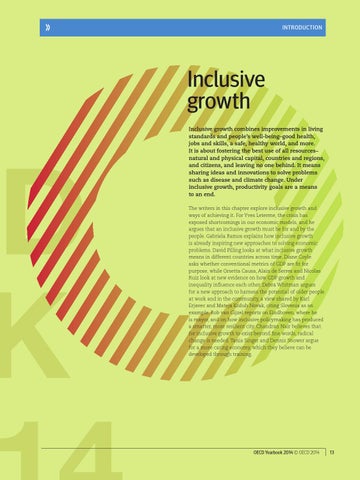INTRODUCTION
Inclusive growth Inclusive growth combines improvements in living standards and people’s well-being–good health, jobs and skills, a safe, healthy world, and more. It is about fostering the best use of all resources– natural and physical capital, countries and regions, and citizens, and leaving no one behind. It means sharing ideas and innovations to solve problems such as disease and climate change. Under inclusive growth, productivity goals are a means to an end. The writers in this chapter explore inclusive growth and ways of achieving it. For Yves Leterme, the crisis has exposed shortcomings in our economic models, and he argues that an inclusive growth must be for and by the people. Gabriela Ramos explains how inclusive growth is already inspiring new approaches to solving economic problems. David Pilling looks at what inclusive growth means in different countries across time. Diane Coyle asks whether conventional metrics of GDP are fit for purpose, while Orsetta Causa, Alain de Serres and Nicolas Ruiz look at new evidence on how GDP growth and inequality influence each other. Debra Whitman argues for a new approach to harness the potential of older people at work and in the community, a view shared by Karl Erjavec and Mateja Kožuh Novak, citing Slovenia as an example. Rob van Gijzel reports on Eindhoven, where he is mayor, and on how inclusive policymaking has produced a smarter, more resilient city. Chandran Nair believes that for inclusive growth to exist beyond fine words, radical change is needed. Tania Singer and Dennis Snower argue for a more caring economy, which they believe can be developed through training.
OECD Yearbook 2014 © OECD 2014
13
